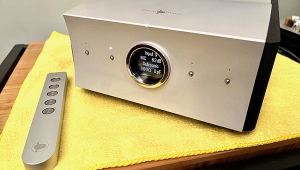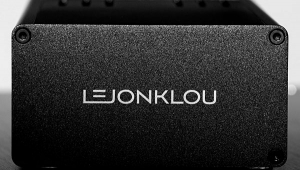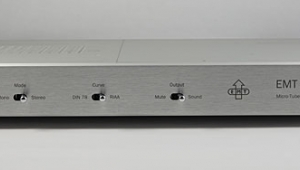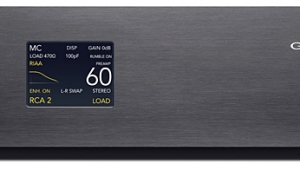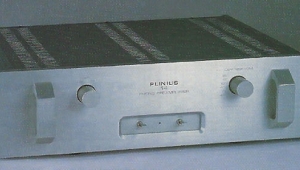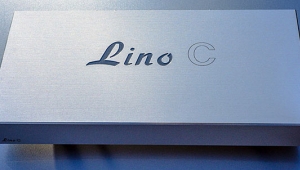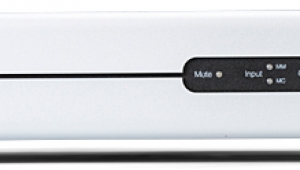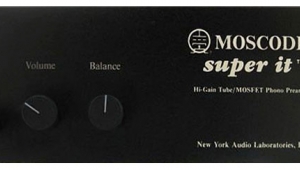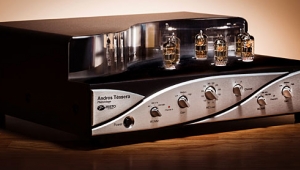| Columns Retired Columns & Blogs |
Sonic Frontiers Phono One phono preamplifier
I've been in love with British sports cars ever since a visiting highway engineer brought a green MGB-GT to my tiny Nebraska town 30 years ago. Since then, there's been a steady stream of ferocious little cars in my life. Triumphs, MGs, Healeys, you name it—right up to my current crop, a Triumph TR6 and roughly two-and-a-half Jensen-Healeys.
 But in the years since that first MGB-GT, I've seen British sports cars evolve from a mainstream automotive option to being marginalized—if not actually replaced—by alternatives like the Datsun 240Z, and finally relegated to being little more than a nostalgic segment of automotive history.
But in the years since that first MGB-GT, I've seen British sports cars evolve from a mainstream automotive option to being marginalized—if not actually replaced—by alternatives like the Datsun 240Z, and finally relegated to being little more than a nostalgic segment of automotive history.
I got my first driver's license in 1973, about when the middle stage of this evolution began. The last of the classic sports cars were disappearing from the showrooms, the mainstream public had moved on, and modern alternatives like the Mazda Miata and BMW Z-3 were still decades away. On the other hand, the specialty market was thriving. Shops and products that catered to British sports cars were springing up everywhere you looked. Clean, low-mileage used cars were readily available at reasonable prices. If there was ever a time to squirrel away a nice, low-mileage Austin-Healey 3000 or Jaguar E Type, it was then.
I can't help but see parallels between the state of the LP today and that middle stage of the British sports cars' downhill glide. CDs have driven vinyl from the mainstream racks, but they can't quite duplicate its performance and feel. A true replacement—perhaps high-resolution digital—is still just over the horizon. There's a thriving used trade, and in the specialty market new products are introduced daily. This is a great time—perhaps the last chance—to fill out an LP collection and shop for the analog playback equivalent to that Healey or XKE.
SFI Phono One
Future preamps will be line-stage–only, so your ultimate analog system had better include a phono stage.
Fortunately, there are lots of choices. The Audio Research PH3 ($1495), the Linn Linto ($1500), and the Acoustech PH-1 ($1200) are all great choices in the $1000–$2000 price range. Now, Sonic Frontiers International has joined in with their $1999 Phono One.
The Phono One is a versatile, lavishly constructed product, and matches the handsome cosmetics of SFI's current line-stages. Front-panel controls are limited to buttons for power and mute. Mute comes configured as a 9dB attenuator, but can be changed to turn off the signal entirely. An LED glows steadily when the unit is powered up, and blinks when the signal is muted. The rear panel has RCA inputs and outputs, and DIP switches to set the cartridge loading. A wide range of loading values is available, and posts are provided inside the unit so the customer can install additional resistors and capacitors.
The Phono One is a hybrid design. It uses a single JFET per channel as an input, followed by a 6922-based triple-series amplifier as a second stage. The output stage uses another 6922 as a cathode follower to lower the unit's output impedance. The circuit is noninverting and uses frequency-dependent feedback for equalization, with a single compensation network being "fed from a fairly low impedance, thereby avoiding slew-limiting at high frequencies." 54dB of gain is standard, but 44dB and 62dB are also available as special orders from the factory.
Inside, things are laid out neatly and suggest a close attention to detail. Separate, elastomer-mounted boards are used for the power-supply, signal-carrying, and I/O sections. The parts spec includes SFI-branded Sovtek tubes, MultiCap and Solen caps, Roederstein, Vishay, and Mills resistors, a beefy toroidal transformer, and silver Kimber Kable for internal wiring. The chassis and top cover are even treated with Soundcoat to damp vibrations.
SFI President Chris Johnson confirms that considerable effort went into optimization. "God is in the details...things like the power-supply regulation, more than the basic circuit. Our goal was to build an ultra-high-gain, ultra-low-noise tube phono stage. We spent a tremendous amount of effort on making it quiet—things like circuit-board layout and grounding....Our JFETs are Japanese—difficult to source in North America, but very quiet. Then we encapsulate them, because we found out that they were sensitive to air currents within the chassis. We use shunt regulation for the power supply...it's expensive and inefficient, but has less than half the noise of the best series-regulator stages. That saved us 2–3dB. Our toroidal transformer is completely encased in silicon steel, which saved another 4dB. Our previous product, the SFP-1, had 57dB of gain and 72dB signal/noise ratio. With the Phono One we were able to achieve 62dB of gain and an S/N of 84dB."
Systems and setup
I've used the Phono One sans tweaks in a variety of systems, mostly driving its companion Line Three line-stage and fed by either a Micro-Benz LO4 or Clearaudio Gamma Gold cartridge. Synergistic Research and Kimber cables were used around it, and it rested atop a Merrill equipment stand. Power was delivered through a PAC Super IDOS, with a Nirvana isolation transformer added to further isolate digital sources, and an AudioPrism Quiet-Line filter sharing the outlet. The Acoustech PH-1 (reviewed by Wes Phillips in the June 1998 Stereophile) and VAC CPA-1 Mk.II were on hand for comparisons.
Sound
Nothing. That's the first thing that struck me about the Phono One. Until the stylus touched the vinyl, there was nothing there...dead silence. Sonic Frontiers' efforts to reduce noise seemed to have succeeded spectacularly. The Phono One wasn't quiet "for a tube unit," it was quiet period. What's more, it was as quiet after nine months of continuous use as it had been right out of the box.
Even after the music started, "Nothing" remained my initial impression. Nothing, that is, in the sense that nothing jumped out to demand my attention. The music was there, sure—there were balanced, lifelike images, and a large, coherent soundstage laid out across my listening room. But there were no obvious characteristics that provided an easy handle to grab or made a strong first impression.
The Acoustech PH-1, in comparison, was immediately striking in how it sharply outlined images and subtly highlighted deeply buried countermelodies. Similarly, the VAC's vivid tonal colors and dimensionality always caught my attention and kept me glued to the listening chair. That's not to say that the Phono One wasn't musically engaging—it definitely was. Session after session, I would try to concentrate on critiquing the system's performance but ended up focusing on the music instead. The Sonic Frontiers just didn't make its presence known as clearly as most components I've heard.
Two factors that contributed to the Phono One's elusiveness were its tonal neutrality and balance. Its overall frequency response sounded flat, and individual instruments' harmonic balance seemed right, free from obvious colorations. Dynamics, detail, and pitch definition were better in the midrange than at the frequency extremes, but the differences weren't huge. Double basses didn't have quite the pitch definition of, say, a clarinet, and cymbals and triangles didn't have quite as much bell-like fundamental ring as they should. The transitions were gradual, however; a slight midrange highlighting was apparent, though it didn't stand out or get in the way of the music.
The re-creation of images and their relationship with the surrounding space was an area where the Phono One excelled. Images were dense and realistically dimensional. Their edges were clearly defined—not by unnaturally distinct outlines, but by a smooth interaction between the instruments' sounds and the surrounding space. If anything, the SFI erred slightly to the side of coherence rather than definition. Regardless, image edges were reproduced equally well in all three dimensions, interacting and blending very naturally with the surrounding space.
The Phono One did a very good job of reproducing a soundstage, and of locating the images in it. The stage width stretched to slightly beyond the speakers, which is good but not great, compared to other preamps I've used. The overall depth of the stage, however, and the precision and consistency of the front-to-back layering, were superb. Ambience retrieval was excellent as well, my only quibble being that the soundstage never sounded completely transparent. The SFI had a slight liquid texture that filled in the spaces between instruments and subtly thickened the ambience. That's a nit, however, in the face of the Phono One's excellence in this area. If the recording was made in a real space, its components—width, height, depth, ambience, the sense of space and hall boundaries—were reproduced faithfully and woven into a seamless sonic picture.
The Phono One was good in each of these areas, but its greatest strength was how well they all fit together. The overall picture was so coherent and well-balanced that the tendency was to ignore it altogether, to briefly register, "Yeah, that's right," and move on to the music. The Reiner/Chicago reading of Prokofiev's Lieutenant Kij;ae (RCA/Chesky RC10) was a good example. Right from the distant trumpet and drum at the opening, images were sized and located correctly with respect to the audience, soundstage, and surrounding space. I cued up this album several times, each time vowing to carefully analyze the size and perspective of each image, or each component of the frequency spectrum. Each time, however, the orchestration would build and I'd find myself absorbed in the overall sonic space, and the performance itself.
The Ray Brown Trio's Soular Energy (Concord Jazz/Bellaphon LELP 111) was another good example. There's no soundstage per se on this recording, but is a good sense of dimensionality and layering, and of each instrument occupying and interacting with a particular volume of space. The Phono One captured these characteristics and relationships correctly. In contrast, the Acoustech PH-1 produced images that were more sharply bounded but with less dimensionality. There was no sense of layering or space; the piano and tenor sax alternated at being pasted on top of each other.
The Sonic Frontiers' resolution of low-level detail in complex passages wasn't as good as some I've heard. This shortcoming wasn't obvious or jarring, but more a case of "if you don't know it's there, you'll never miss it." Even familiar recordings like Lt. 233Kij&#; seemed to have a realistic level of detail. However, switching to the Acoustech PH-1 exposed what the SFI had missed. Quiet countermelodies, like the bouncing clarinet line at the opening of the second movement, were obvious with the PH-1. The line was there with the Phono One, but you had to listen closely and concentrate to follow it.
In contrast with its obscuring of low-level details inside complex passages, the Phono One's resolution was excellent on simple arrangements, and within lead instruments. On Soular Energy, Ray Brown's bass and Gene Harris' piano were beautifully detailed. The instruments and voices on "Under the Boardwalk," from Rickie Lee Jones' Girl At Her Volcano EP (Warner Bros. 23805-1), were vibrant and detailed; "Hey Nineteen," from Steely Dan's Gaucho (Japanese MCA VIM-6243), was stunning. On Lt. Kijé, I could follow individual instruments within swelling violin sections, but not the faint, muted trumpets underneath.
A great example of the SFI's detail resolution—both strengths and weaknesses—was the short, third-movement Impromptu in the Martinon/Paris Conservatoire performance of Bizet's Jeux D'Enfants (London STS 15093). At one point, a soft trumpet softly plays at the rear of the stage beneath massed, plucked violins at the front. With the SFI, the violins were beautifully detailed, individual instruments distinct and precisely located. On the other hand, it required concentration to hear the trumpet line, much less follow it or get a sense of the instrument's tonal quality. Still, until I knew to listen for the countermelody and concentrated on doing so, I was content to simply revel in the lovely strings—and in the music itself.
The Phono One's reproduction of dynamic transients paralleled and contributed to its apparent detail resolution. Large transients were produced very well, especially in simple arrangements, or for leads or small groups. Bizet's sudden string crescendos, for example, were startling in their impact. However, low-level countermelodies were limited in their dynamic range, as if the SFI's ability to reproduce dynamics decreased progressively as the overall level dropped from fff to f, p, and ppp.
Another component of the Phono One's sound was a slight blurring at the leading edges of transients, particularly at the frequency extremes. On Lt. Kijé, the bass-drum transient had impact and power, but the initial mallet stroke wasn't as clear as it was with the Acoustech PH-1. The SFI's initial transient also had a bit of overhang, enough to obscure the split second of skin sound between the initial stroke and expanding boom of the drum's body. The leading edges of transients were blurred at the top end as well. On "Sweet Georgia Brown" from Soular Energy, high piano runs became more like glissandos, with the initial transients lost inside the previous notes' resonance.
Putting it back together
All of these attributes, these strengths and weaknesses, were components of the Phono One's sound. I could isolate them and verify their existence. A more significant truth—at least for me—was that none of the Sonic Frontiers' individual characteristics jumped out to interject themselves between me and the music. For the most part, they were consistent with the fabric of the music, not superimposed on it.
It's also true that most of the Phono One's shortcomings had the effect of reducing the overall focus and impact of the presentation by softening some of the finest spatial and temporal details. The effect is subtle, though. I'm particularly critical of components' performance in this area, and I never found the SFI's cumulative omissions sufficient to rob the music of its vibrancy and life.
So, is the Sonic Frontiers Phono One the analog equivalent of that Lotus Elan or XKE? Is this one to grab while it's still available, and park in your listening room? It's certainly a good choice, and one that I could happily live with. I preferred the Phono One's coherent, dimensional presentation to the Acoustech PH-1's more detailed one, but the latter did highlight the SFI's shortcomings. Conversely, I marginally preferred the VAC CPA-1 Mk.II's onboard phono stage to the SFI, but the Phono One showed how quiet a tube unit could be, and sounded more neutral than the VAC.
It's a question of finding the one that best matches your system and listening tastes. I definitely recommend auditioning the Phono One if it's within your price range. But one thing's for certain: I'm not going to miss the chance to set up a killer analog playback system. I've got 10,000 LPs—and a vivid memory of this gorgeous blue XKE coupe...
- Log in or register to post comments
